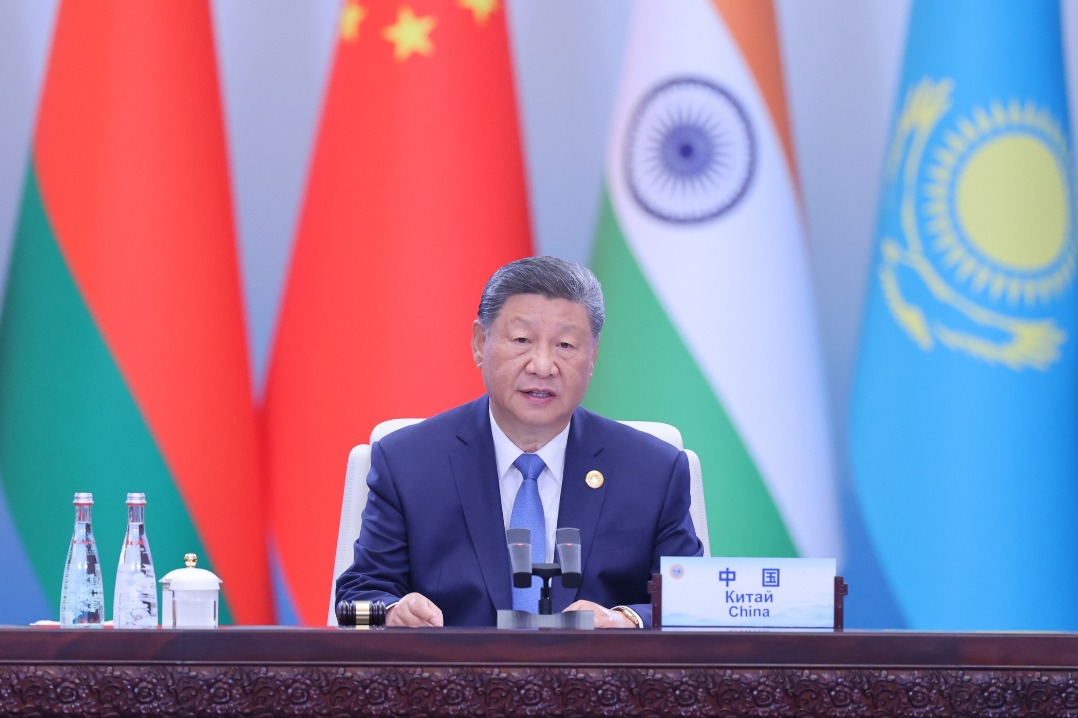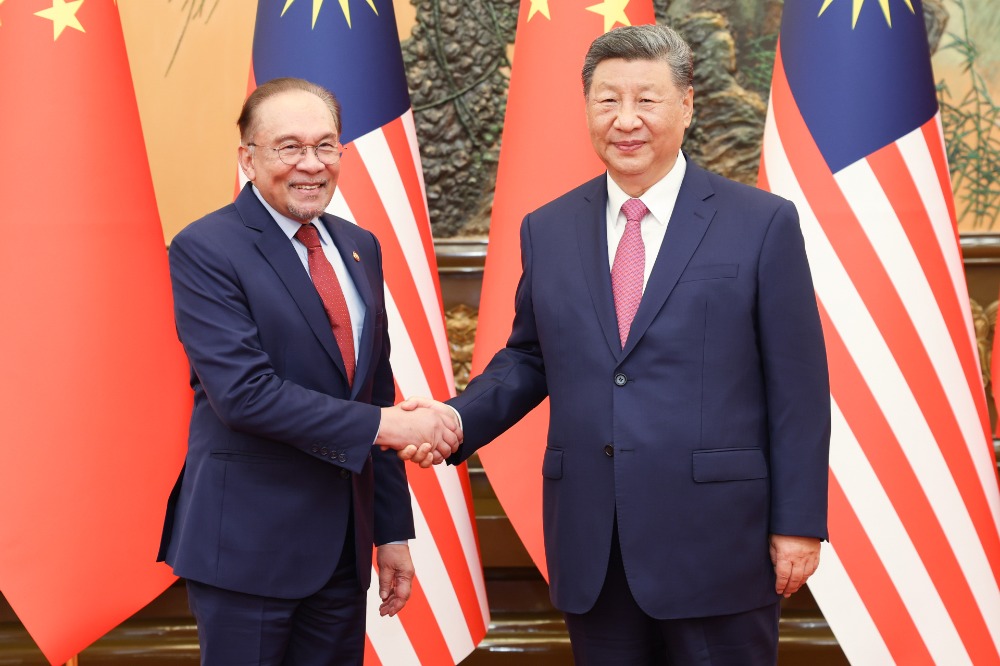Risk mitigation


Asian economies should cooperate to jointly lower their overreliance on dollar-denominated assets
The economic and trade policies implemented by the current administration of the United States have heightened the risks associated with dollar-denominated assets. While President Donald Trump's "reciprocal tariffs" policy is allegedly intended to reduce the US trade deficit, it has significantly undermined the dollar's global safe-haven appeal, triggering a wave of sell-offs of US Treasuries in the short term.
The surge in US debt default risks has sharply driven up its bond yields. In May, the yield on 30-year US Treasury bonds touched a high of 5 percent for several days — a level comparable to 2007 — reflecting the erosion of global market confidence in US bonds.
The US fiscal situation has also significantly worsened, undermining the confidence in the US dollar. On May 16, Moody's Ratings announced a downgrade of the US sovereign credit rating from Aaa to Aa1 due to wider fiscal deficits and higher interest payments, while revising its outlook from "negative "to "stable". With this move, all three major international credit ratings agencies have now stripped the US of its triple-A rating.
The US Congress has passed the "One Big Beautiful Bill Act", which combines tax cuts with increased spending while raising the federal debt ceiling by $5 trillion. Although this provides temporary relief from a debt ceiling crisis, it paves the way for even greater debt growth. US national debt has now surged past $36.2 trillion, with interest payments becoming the fastest-growing part of federal expenditures.
The loss of top-tier credit rating has intensified global investors' concerns over the runaway fiscal deficits of the US and its unsustainable debt burdens, forcing markets to reassess the safety of dollar-denominated assets.
As major holders of dollar assets, Asian economies are particularly prone to the growing US debt risks. According to US Treasury data, as of June 2024, Asian economies held nearly $9 trillion in US securities, accounting for 29 percent of all foreign-held US debt. The largest holders include Japan, the Chinese mainland, Singapore, the Republic of Korea, and China's regions of Taiwan and Hong Kong.
With rising US debt risks, Asian economies have gradually reduced their Treasury holdings. By April, Japan's US debt holdings fell to $1.13 trillion, down $32.6 billion from its 2024 peak. And the Chinese mainland's holdings dropped to $757.2 billion in the same month.
Reducing dollar asset holdings is only one approach to coping with the eroded credibility of US dollar. In the long run, Asia must strengthen its regional currencies and financial cooperation to fundamentally get rid of its dependence on the US dollar.
First, it needs to further improve the regional financial safety net.
Since the Asian financial crisis in 1997, the region has enhanced monetary cooperation and made significant progress in building its financial safety net.
The Chiang Mai Initiative Multilateralization (CMIM) has continuously expanded its funding pool while substantially reducing the International Monetary Fund-linked portion. In addition to the US dollar, CMIM has introduced provisions for local currency contributions, strengthening regional ownership. Additionally, the ASEAN+3 Macroeconomic Research Office (AMRO), which was upgraded to an international organization in February 2016, has played an increasingly vital role in supporting the CMIM implementation and enhancing regional macroeconomic surveillance.
Moving forward, Asia should further expand the CMIM, diversify its lending tools, and make these tools more flexible and targeted. At the same time, AMRO's governance structure and capacity-building must be reinforced, with the ultimate goal of merging CMIM and AMRO — or even establishing an "Asian Monetary Fund" — to bolster regional financial stability.
Second, the region should continuously promote the use of local currencies.
Currency mismatch — where assets and liabilities are denominated in different currencies — was one of the contributing factors to the 1997 Asian financial crisis. Following the crisis, Asian countries launched the Asian Bond Markets Initiative to address currency and maturity mismatches by developing local currency bond markets, thereby channeling regional savings into local investments.
Asia has also actively promoted cross-border trade settlement in local currencies. Since 2016, countries including Thailand, Malaysia, Indonesia and the Philippines have launched local currency settlement frameworks. In 2019, the Association of Southeast Asian Nations completed the ASEAN Guiding Principles on Local Currency Settlement Framework, aiming to extend existing local currency settlement arrangements to all member states. Some ASEAN members have also signed similar agreements with Japan, China and the ROK.
In May, the central banks of China and Indonesia signed a memorandum of understanding to expand local currency settlement cooperation from current accounts and direct investment to all transactions, including capital and financial accounts, further boosting the use of local currencies in bilateral trade and investment.
Looking ahead, Asian nations should further refine the mechanisms for bilateral local currency settlement, currency swaps and direct currency trading. By jointly advancing the use of local currencies, they can deepen bilateral economic and trade cooperation, and reduce the reliance on external currencies.
Third, regional countries should strengthen cooperation in digital currency.
Digital currencies are not only reshaping the international monetary system, but also driving reforms in the cross-border payment system.
Currently, the digital currency sector in Asia is experiencing rapid growth. In the field of central bank digital currencies, China has expanded the use of the digital renminbi to more areas, and most Asian economies either have begun pilot programs for central bank digital currencies or are developing their own digital currencies.
In addition to promoting central bank digital currencies at home, some Asian countries are actively advancing regional cooperation in digital currencies. For example, China, Thailand, Singapore and Malaysia are enhancing cross-border payment efficiency through the multi-central bank digital currency platform.
In the future, more Asian economies should be encouraged to join the cooperation platforms to further facilitate cross-border payments within the region.
Cryptocurrencies and stablecoins are also rapidly developing in Asia. After Donald Trump's re-election, he has placed a high priority on the development of cryptocurrencies, particularly stablecoins, aiming to use them to maintain the dominance of the US dollar.
This strategic shift of the US has fueled the development of stablecoins in Asia. Asia should improve its regulatory framework and strengthen regional regulatory coordination and cooperation, seeking a balance between innovation and financial stability, so as to gain the upper hand in the new global currency competition.
The author is an associate research fellow at the Institute of World Economics and Politics at the Chinese Academy of Social Sciences. The author contributed this article to China Watch, a think tank powered by China Daily.
Contact the editor at editor@chinawatch.cn.


































